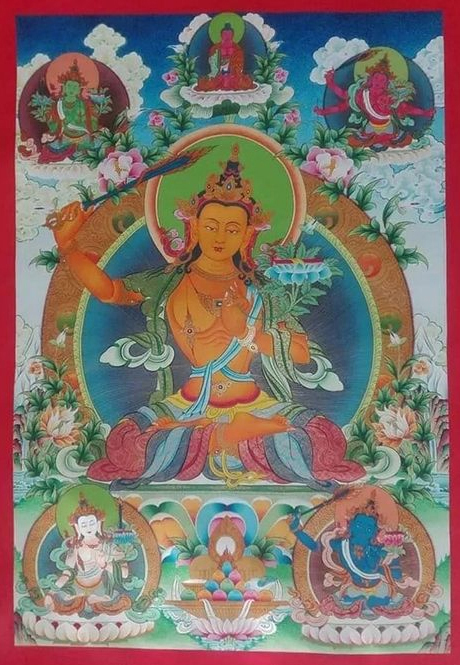 The Nepal Weekly
The Nepal Weekly  January 31, 2023
January 31, 2023
Manjushree is worshipped as Saraswati, the goddess of knowledge and wisdom on the day of Shree Panchami every year according to Lunar calendar that corresponds on 26th January this year.
Manjushree is regarded to be the proponder of Mahayana school of Buddhis philosophy, the origin of Saddharmapundarika and Prajnaparmita. It is said that they are the outcome of his meditation. Therefore he is worshipped as a revered deity of knowledge and wisdom by Buddhists and Hindus alike in Nepal. Because of profound knowledge attributed to him he is revered as a Bodhisatwa who could bestow blessings to any devotee to fulfill his or her wishes.
He came from China to see and offer his prayers to Swayambhu, self-existent one. Swayambhu Purana mentions this story of the visit of Manjushree to Nepal. At that time the Kathmandu valley was full of water like a lake. Manjushree cut a gorge at Chobhar with is sword of wisdom and allowed water of the lake to flow out of the valley.
Manjushree is worshipped as Saraswati, the goddess of knowledge and wisdom on the day of Shree Panchami every year according to Lunar calendar that corresponds on 26thJanuary this year. People visit temple of Saraswati on this occasion. A temple of Manjushree in Swayambhu is visited by many worshippers on this day. Likewise, devotees visit Saraswati temples at Lele, Lazimpat, Bhaktapur and many places including the temples built in the schools and colleges across the country.
Within Bajrayan Buddhism, Manjushree is a meditational deity and considered a fully enlightened Buddha. In Shingon Buddhism, he is one of the Thirteen Buddhas to whom disciples devote themselves.
Manjushree is depicted as a male Bodhisatwa wielding a flaming sword in his right hand, representing the realization of transcendent wisdom which cuts down ignorance and duality. The scripture supported by the padma (lotus) held in his left hand is a Prajñâpâramitâsûtra, representing his attainment of ultimate realization from the blossoming of wisdom. Manjushree is often depicted as riding on a blue lionor sitting on the skin of a lion. This represents the use of wisdom to tame the mind, which is compared to riding or subduing a ferocious lion.
He is one of the Four Great Bodhisatwas of Chinese Buddhism, the other three being Kcitigarbha, Avalokiteœvara, and Samantabhadra. In China, he is often paired with Samantabhadra. Similarly, in Tibetan Buddhism, Manjushree is sometimes depicted in a trinity with Avalokiteœvara and Bajrapani.
In the legends, Manjushree had created the Kathmandu Valley civilisation. He firstly drained out the water of the lake which is now the Kathmandu Valley from Chobhar George. Secondly, he helped grow human settlements and livelihood. Thirdly, king was selected to take over the rules and administration. Earlier but after draining out water of the lake, he decided to expose the flame of Swayambhu and all the sacred locations that were underwater and entered into a deep meditation on how best to do this. And when he had seen how he could do it, he summoned all his strength and with a mighty roar raised his shining sword above his head and brought it down upon Kotval Mountain, cleaving it in two. Then he slashed further clefts at Chobar, Gokarna and Aryaghat and the water began gushing out, crashing in silvery cascades towards India.
The Nagas, great snake kings, realising that their precious home was being destroyed, came to Manjushree in despair. Manjushree told them he wished them no harm and was sorry that, for the greater good of men and all sentient beings, it had been necessary for him to drain the lake, and he implored the Nagas not to leave the Valley but to take up residence in a special pond he would create for them; and he assured them that they would receive worship from humankind forever. Manjushree knew that the Nagas were auspicious beings who knew the secrets of rain and wealth and other things that would be of great assistance to the future inhabitants of this land.
The Nagas acquiesced and slithered into their new home in Taudaha pond. Here the great Karkotak, kind of the Nagas, constructed a magnificent underwater durbar, and Karkotak’s queen sat on a throne studded with jewels, shaded with three umbrellas of white diamonds one above the other. And though, in years to come, men tried to drain this pond in order to find this durbar and steal its treasures, none has succeeded. The pond of Taudaha is where Karkotak and his beautiful queen dwell to these days.





